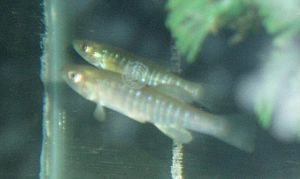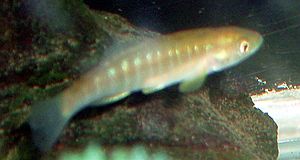Banded killifish facts for kids
Quick facts for kids Banded killifish |
|
|---|---|
 |
|
| Conservation status | |
| Scientific classification | |
| Subspecies | |
|
|
 |
|
| Range of the banded killifish | |
| Synonyms | |
|
The banded killifish (Fundulus diaphanus) is a type of small fish found in North America. It lives mostly in freshwater. You can find it from Newfoundland in Canada, down to South Carolina, and west to Minnesota. It also lives in the areas around the Great Lakes. It's the only freshwater killifish in the northeastern United States. Even though it prefers freshwater, it can sometimes live in brackish water (water that's a mix of fresh and salty).
Contents
What's in a Name?
The name "banded killifish" comes from the clear black and white stripes on its sides. Its Latin name, Fundulus, means "bottom" (because it often swims near the bottom). The second part of its name, diaphanus, is Greek for "transparent."
What Does It Look Like?
The banded killifish has an olive-green color on its back and white on its belly. Its throat and fins are yellowish. It has vertical black and silver-white stripes along its sides.
This fish has 13 to 15 rays on its dorsal fin (the one on its back). It has 10 to 12 rays on its anal fin (the one on its underside). Its tail is slightly rounded. It also has a small pelvic fin (on its belly). The fish's body is long and thin, with flat sides and a flat head. It has a small mouth at the very front, which is good for eating food from the water's surface. The banded killifish has tiny, sharp teeth in its upper and lower jaws. It doesn't have a lateral line (a sensory organ) along its side. However, it has 39 to 43 cycloid scales (smooth, round scales) in a row along its side.
An average banded killifish is about 10 to 13 centimeters (4 to 5 inches) long. It weighs only a few grams. Female killifish usually grow larger than males. Females also have darker bands on their sides. Males have pale gray bands that are closer together. The number of bands on a banded killifish's dorsal fin can help tell if it's a male or female.
Where Do They Live?
Banded killifish are found all over eastern North America. Their range goes from South Carolina up to the Atlantic Provinces in Canada. They also live in eastern Montana to Minnesota. You can find them in good habitats within the Great Lakes watershed from southern Ontario to Lake Superior. Because they are isolated and can't easily spread to new areas, the Committee on the Status of Endangered Wildlife in Canada (COSEWIC) has listed them as a species of special concern.
There are two types (subspecies) of banded killifish: the eastern banded killifish (Fundulus diaphanus diaphanus) and the western banded killifish (Fundulus diaphanus menona). The eastern type is considered an invasive species in Ohio. Both types mix in the Saint Lawrence and Lake Erie areas. The eastern subspecies is usually bigger.
Their Home and Lifestyle
Adult banded killifish usually live for 2 to 3 years. These fish are schooling fish. This means they like to swim together in groups. Adults usually travel in groups of 3 to 6 fish. Younger fish (juveniles) travel in larger groups of 8 to 12.
You'll often find banded killifish in shallow, calm parts of clear lakes, ponds, rivers, and estuaries. They prefer places with sandy or muddy bottoms and lots of water plants. The sand and gravel give young fish places to hide. They hide from bigger fish that might eat them. These predators include largemouth bass (Micropterus salmoides), northern pike (Esox lucius), bluegill (Lepomis macrochirus), and trout.
Because banded killifish are small, they usually don't go into deep water. Deep water can have strong currents, and they would be easier targets for predators. However, adult killifish have been seen going into deeper water to find food. Banded killifish often gather near water plants. These plants offer protection and good places for them to lay eggs.
Banded killifish are euryhaline. This means they can live in both fresh and salty water. But they usually live in freshwater streams and lakes. The largest adult ever recorded was 12.8 centimeters (about 5 inches) long. People have used banded killifish as fish bait. They are not usually kept as pets because they need a lot of care to survive in an aquarium.
These fish are important to water ecosystems. They are a food source for larger fish like largemouth bass, northern pike, and trout. They are also eaten by birds such as belted kingfisher (Megaceryle alcyon), common merganser (Mergus merganser), and herons.
In January 2005, the banded killifish was listed as a vulnerable species. This was under the Newfoundland Labrador Endangered Species Act and the Canada Species at Risk Act (SARA). This species is losing its habitat. This is due to things like building projects, boats, and removing water plants.
What Do They Eat?
Banded killifish have been seen eating food at all levels of the water. Adult fish eat many different things. These include insects, insect larvae (nymphs), mollusks (like snails), and small crustaceans (like tiny shrimp). Mosquito larvae are also a favorite food. Smaller, younger fish eat fewer types of food. They mostly eat tiny insect larvae (like chironomid larvae and midge larvae), cladocerans, and copepods. Both young and adult banded killifish usually eat most in the afternoon.
How Do They Reproduce?
Banded killifish often lay their eggs in thick water plants. They use external fertilization. This means the female lays her eggs, and then the male fertilizes them outside her body. The eggs have sticky threads that help them attach to plants. Spawning (laying eggs) happens from June to mid-August in shallow water.
During the spawning season, male killifish change color. They get a bright blue patch near their anal fin. The lower part of their body also turns bright blue. Spawning happens when the water temperature is about 21˚C to 23˚C (70˚F to 73˚F). The male chooses a spot in the shallow water and protects it from other males. When a female appears, the male will try to attract her and fight off other males. The female will lay one egg at a time while the male follows her. Once they are together, the female lays about 10 eggs. These eggs fall to the bottom or stick to plants in the chosen area. The male will keep following the female until she has laid 50 to 100 eggs.
A single female can lay several groups of eggs during one summer. After the eggs are fertilized, both parents leave. They do not take care of their eggs. Tiny fish, called fries, hatch within 10 to 12 days. The exact time depends on the water temperature. They grow to adult size at about 1 year old, when they are about 6 centimeters (2.4 inches) long. Banded killifish usually live for a little over 2 years. Some have been seen to live up to 3 years.
How Do They Behave?
Swimming in Groups (Shoaling)
Banded killifish form groups called shoals. How and why they form these groups can change a lot. Being in a group has both good and bad points. These depend on how much food is available and how much danger there is from predators. Bigger groups offer better protection from predators. But in big groups, there is less food for each fish because it's shared among many. In smaller groups, there isn't as much protection from predators. But each fish gets more access to food.
How hungry a banded killifish is affects if it joins a shoal or not. Fish that haven't eaten much spend more time alone. When hungry fish are in shoals, their groups are not smaller than those of well-fed fish. Hungry banded killifish are more likely to leave a shoal than fish that have eaten well.
When there is food nearby, group sizes get smaller. This means each fish doesn't have to compete as much for food. If they smell food, fish are less interested in staying close to their neighbors. But if they sense a predator, they are more attracted to their neighbors and form tighter groups. If both food and a predator are present, the group size is somewhere in the middle.
When a predator is nearby, banded killifish try to eat less. They also spend less time in a feeding position. This is so they can use more energy to watch out for and avoid predators. Whether a predator is present or not, how fast a banded killifish eats doesn't depend on the size of its group. Fish that are alone face more danger. They don't get the protection that a shoal offers. So, they will try to join larger groups rather than smaller ones. When deciding whether to join a group, banded killifish care more about safety from predators than finding food.
Protection from Predators
When a predator is nearby, the shoal size increases. This gives better protection through the dilution effect. The dilution effect means that in a larger group, each individual fish has a smaller chance of being attacked. This is because there are many other fish in the group. In a big group, a predator is more likely to attack another fish than the one you are watching. Fish that swim away from the group are more likely to be caught. This is why natural selection favors grouping.
Besides the dilution effect, shoaling also helps fish because of group vigilance. To best protect against predators, banded killifish must watch out for them. In a group, each fish can spend less time looking for predators. This is because others in the group share this job. As the group gets bigger, each fish spends less time watching. But with more fish, the group as a whole watches more. This helps every fish in the shoal. When one fish sees a predator, it makes an alarm call. This warns the rest of the group. Then, the fish can act to protect themselves from the predator.
To avoid predators better, banded killifish often hide. Scared fish, when a predator is nearby, will hide in a safe spot where there is no food. This choice depends on the fish's size. Larger fish spend more time hiding than smaller fish of the same species. Smaller banded killifish are more willing to take risks than larger ones.
See also
 In Spanish: Fundulus diaphanus para niños
In Spanish: Fundulus diaphanus para niños



